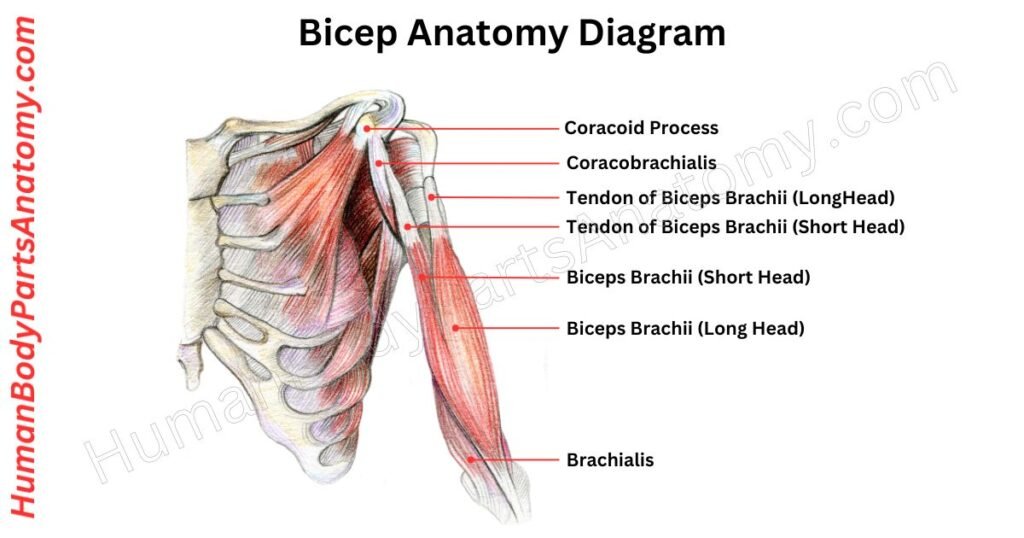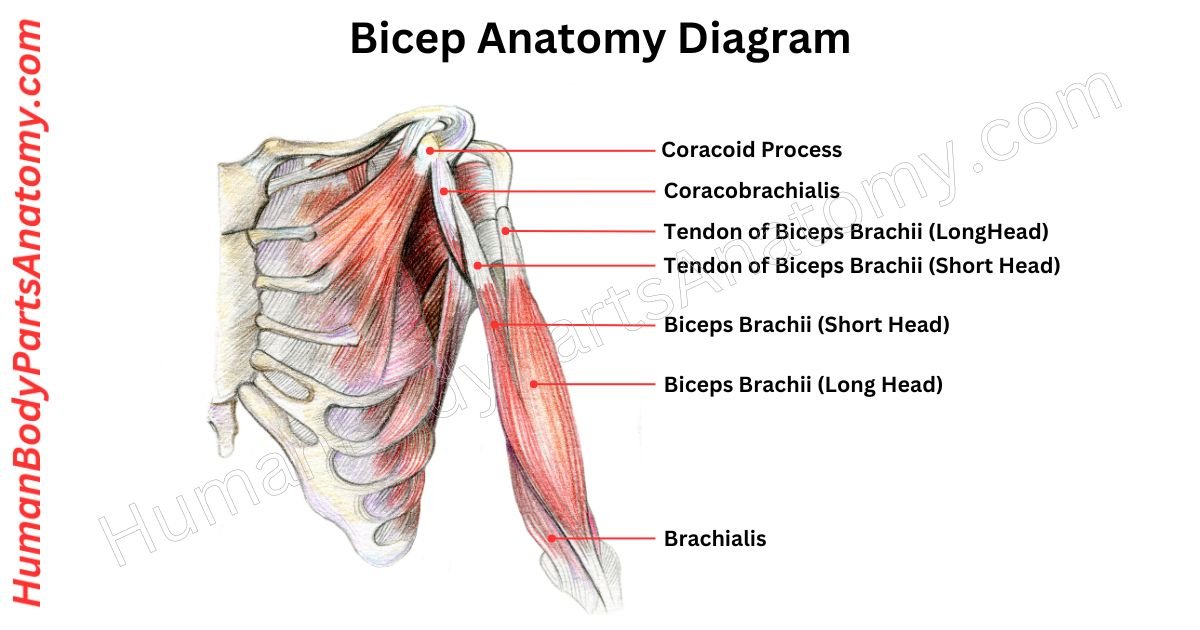Overview of Biceps Anatomy
The biceps is an important part of the upper arm. We call it a single muscle, but it actually consists of a short and a long head. The short head starts at the coracoid, while the long head originates from the supraglenoid tubercle. Both parts share the same nerve supply with the coracobrachialis and brachialis muscles. One good thing about the biceps is its attachment to two points in the shoulder – the coracoid process and supraglenoid tubercle. What makes the biceps unique is its ability to span two joints, the shoulder and elbow, setting it apart from other muscles in the upper arm’s front compartment. In this article, we will see a detailed bicep anatomy with its different parts and their functions.
Anatomy of Bicep Diagram

Parts of Bicep
- Short head
- Long head
- Brachialis
- Muscle belly
- Innervation
Bicep Anatomy: Parts & Functions
Short Head
The short head, on top of the coracobrachialis muscle, starts at the highest spot on the shoulder blade’s coracoid process. It is where it links up with the beginning of the coracobrachialis tendon.
Long Head
The long head of the biceps starts at the supraglenoid tubercle above the shoulder socket on the shoulder blade. It stays outside the joint but within its surroundings.
The tendon of the long biceps takes a sudden bend at the top of the upper arm bone and moves along the groove between the two bumps on the upper arm bone. This bend is held in place by ligaments in the area around the joint (called the biceps pulley).
Brachialis
The brachialis muscle is a powerhouse deep within the upper arm. This muscle plays a pivotal role in elbow flexion. It gives stability and strength to the joint.
Muscle Belly
When you flex your belly hard, the middle part—the muscle belly—pops up. It’s made up of two parts of the biceps, kind of like ropes woven together. Inside, there are lots of tiny muscle fibers.
These fibers get super strong when your brain tells them to move. Surrounding these fibers is the epimysium protective layer, which helps your muscles look big and strong.
Innervation
The biceps muscle gets its power from a nerve called the musculocutaneous nerve. It comes from a bunch of nerves in your neck and upper back called the brachial plexus. This nerve, which starts from spinal nerves C5-C6, helps the biceps move and work properly.
Read More-
Lower Limb
- Complete Guide on Leg Anatomy with Parts, Functions & Diagram
- Complete Guide to Thigh Muscle Anatomy: Learn Parts, Names & Diagram
- Knee Anatomy: Complete Guide to Parts, Names, Functions & Diagram
- Femur Anatomy: Complete Guide with Parts, Names, Functions & Diagram
Upper Limb
- Comprehensive Guide to Arm Anatomy: Parts, Names & Diagram
- Comprehensive Guide to Hand Anatomy: Parts, Functions & Diagram
- Shoulder Anatomy: Ultimate Guide to Parts, Names, Functions & Diagram
- Complete Guide to Finger Anatomy with Parts, Names, Functions & Diagram
- Wrist Anatomy: Ultimate Guide to Parts, Names, Functions & Diagram
- Complete Guide to Nail Anatomy with all Parts, Names & Diagrams
Human Head
- Ultimate Guide to Eye Anatomy: Parts, Structure, Functions & Diagram
- Tongue Anatomy: Complete Guide with Parts, Names, Functions & Diagram
- Mouth Anatomy: Complete Guide with Parts, Names, Functions & Diagram
- Complete Guide to Tooth Anatomy: Learn Parts, Names & Diagram
- Ultimate Guide to Ear Anatomy: Parts, Structure, Functions & Diagram
External Sources-
- Wikipedia
- KenHub
- Optometrists
- Cleveland Clinic
- American Academy of Ophthalmology

